CIC: Difference between revisions
More languages
More actions
m Linking to German version. |
mNo edit summary |
||
| Line 119: | Line 119: | ||
<gallery> | <gallery> | ||
Image:Valkyrie bridge.jpg|''Valkyrie'''s CIC. | Image:Valkyrie bridge.jpg|''Valkyrie'''s CIC. | ||
Image:Valkyrie CIC.jpg|Full view ''Valkyrie'''s | Image:Valkyrie CIC.jpg|Full view of ''Valkyrie'''s CIC. | ||
</gallery> | </gallery> | ||
Revision as of 03:32, 28 February 2009
- This article discusses the CIC of battlestar Galactica of the Re-imagined Series. The CIC of the battlestar Pegasus contained similar stations.

Colonial battlestars are centrally operated from the Combat Information Center, or CIC, the battlestar's nerve center. It performs both the functions of a bridge and the CIC in naval parlance, as the vessels are also steered from the CIC.
Galactica

Galactica's CIC is a faintly-circular room located deep in the interior "alligator head" of the battlestar, where the main hull meets the midship section. From CIC, the battlestar's tactical and navigational operations are monitored and directed. CIC is a large, two-level complex with three bulkhead exits, which are closed during action stations alerts.
Galactica's CIC is divided into several stations.
- Command and Control
- Communications
- Damage Control
- Navigation
- Helm
- FTL
- Tactical
- Weapons Control
- Engineering and Environment

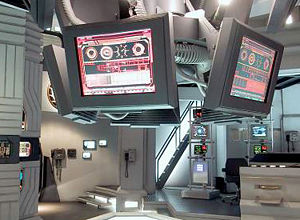
Command and Control
The Command and Control station is the primary station within CIC used by the Commanding and Executive Officers aboard a Colonial battlestar. The center comprises a large communications and a roughly hexagonal "information management" table, with a retractable information display tower bearing a number of LCD screens suspended above it. There are no chairs; the command staff are always standing.
Here, the battlestar's commander and Executive officer are on station, observing and plotting battle tactics, viewing transparent charts, and giving commands to others in CIC. Above the Command and Control Station are a cluster of monitors known as the DRADIS console. The DRADIS console descends from a cylindrical ceiling recess when required. From the Command and Control Station, the commander has a 360-degree view of the CIC. The DRADIS console contains DRADIS displays but also includes other navigation and tactical information available to the commander at a glance. The displays are capable of showing a wide range on information including:
- Countdowns ("33", "You Can't Go Home Again")
- DRADIS sensor readings relayed from the DRADIS console
- Battlestar management information, such as the vessel's spatial orientation (pitch, yaw & roll)
- Battle management information
A Cylon transponder was once mounted on the base of the DRADIS console (Miniseries), supposedly planted there by Aaron Doral.
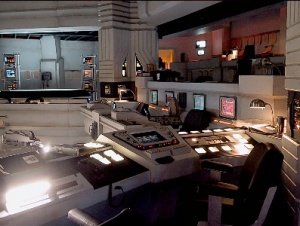
Communications Center
Adjacent to the Command and Control Center on the port side of CIC is the Communications Center. Here, all communications to and from fighters and other ships are monitored, directed or relayed. In coordination with the Tactical Station, the Communications officer can also verify transponders that register as friendly, and alerts the Tactical Officer or commander if they pick up signals without transponders or recognized enemy transponders. The Communications Officer has a link to the mainframe computer, where a library of Colonial recognition information resides.
Damage Control Station
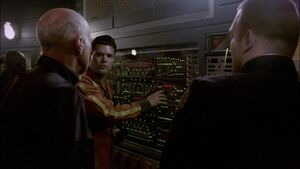
Situated in the far port side of CIC is Damage Control. This station, usually unmanned, contains the Damage Control computers, which connect to many sensors throughout the exterior and interior of the ship. A large display against the wall of the station shows damage through a series of lights that represent the frames, or compartments of the battlestar that form the many segments of the ship.
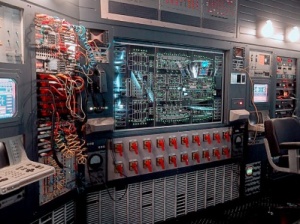
A commander can order a Damage Control officer to perform many actions to repair or mitigate the effects of an enemy attack through the controls here, including the venting of compartments, coordination of damage control teams, and the like. It is also likely that alternative damage control stations outside of CIC, such as the Aft Damage Control room contain similar controls to aid in repairs, control of fires and the like in the event that CIC's damage control is knocked offline or CIC staff are incapacitated.
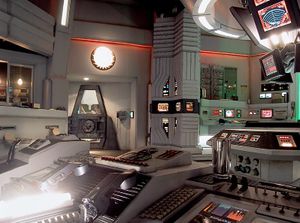
Helm Control
Battlestars move through space much as a submarine navigates in an ocean. There are no windows, no viewscreens to see into space for helm control. While external cameras may be available, they are seldom used in navigation of a battlestar. Navigation is managed by spatial coordinates based on DRADIS and other sensor information. The helm crewmembers drive the battlestar through a series of controls and based on commands from the Executive officer or commanding officer.
Tactical Station
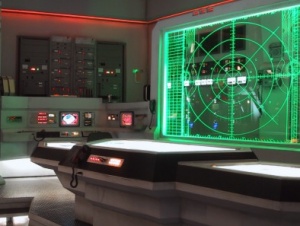
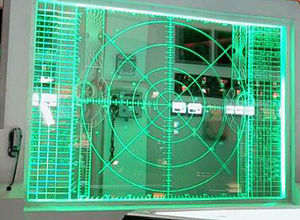
The Officer of the Watch/Tactical Officer is arguably the busiest officer in Galactica's CIC. Tasked with the monitoring of DRADIS and coordinating various command and control functionality, including computer control, the Tactical Officer must relay changes in status and keep the commander updated continuously during the fluid events of battle. The Tactical officer is typically the first to know that an attack is imminent and will address the battlestar by the public address system to go to battle stations through Condition One or Two alerts.
As Galactica's computers aren't networked, the Tactical officer must manually print or offload data from the various central computers he monitors (Fire control, Navigation, FTL, and mainframe computers) and relay this information to the other officers and staff in the room. Fortunately, many stations see the same information on displays similar to those at the Tactical Station, but it is the Tactical Officer who is charged with notifying the commander of the changes and interpreting the results. Galactica's Tactical officer also is the administrator for all central computers onboard and provides maintenance as required.
While the Helm officers drive the ship, it is the Tactical officer that plots FTL jumps, the apparently instantaneous leap from one location in space to another location millions of kilometers away. The Tactical officer of Galactica not only has to provide Jump coordinates to the battlestar's helm, but is also responsible for relaying both scheduled sets and sets of emergency jump coordinates to over 70 other FTL-capable civilian ships that make up the Fleet to ensure that all ships always stay close to Galactica's' protective sphere.
Nearby the Tactical Station is a tactical board and table where the commander can meet with several officers and crew at once for advanced battle or strategy conferences. The Tactical Station is frequently manned by other specialists and officers that assist the Watch Officer.
Weapons Control Room
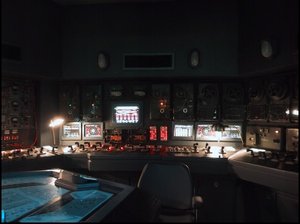
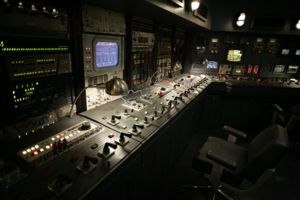
Hidden away, next to the Tactical Station is the Weapons Control Room. Obscured from direct view during most episodes, the Weapons Control Room ostensibly is manned during Action Stations. The battlestar's gun batteries and other defensive controls are managed here.
In the event that the Weapons Control Room or CIC is knocked offline or its crew incapacitated, control of the ship's batteries can be managed at Auxiliary Fire Control.
The Core

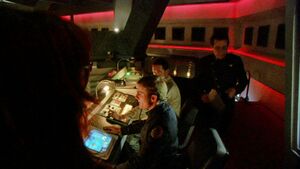
The second deck of the CIC, known only as the "Core", offers a bird's eye view of the busy command deck below. This narrow passageway, lined with a limited set of computers and consoles, extends in a semi-circle from just above the port hatch around the rear of the CIC, over Damage Control, the Communications Center and Helm Control, to just above the starboard hatch. There is also a small room with computers behind the consoles. Two sets of stairs lead up to the Core; one is next to the starboard hatch, and the other is just behind the Communications Center. They can be easily spotted by the blue lights behind them.
The Core often proves to be a conveniently private area of the CIC for William Adama to meet with his associates to discuss delicate affairs while on duty. In "Tigh Me Up, Tigh Me Down" he meets here with Laura Roslin to discuss the creation of Gaius Baltar's Cylon detector, and again in "Kobol's Last Gleaming, Part II" with Saul Tigh to discuss Kara Thrace's desertion to retrieve the Arrow of Apollo.
FTL
The FTL station is in the area behind the Tactical Station. It is not routinely manned, but can be manned by up to two crewmembers. All functions of the FTL drive and computer can be controlled from this station. While the engineering portions of the FTL drive are usually controlled and monitored by engineering staff, this station is sometimes staffed when more complex jumps must be made. This station is where the Tactical Officer plots and executes the jump. Sometimes the Tactical Officer inputs the jump coordinates himself, while other times the station is manned by two seated crewmen. However, the jump is always executed by the Tactical Officer himself. The FTL drive is engaged by inserting a blue "key" into a receptacle at the center of the console and turning it. This console folds down into a table when it is not being used.
Pegasus
Pegasus's CIC is far smaller than Galactica's, reflecting the advanced battlestar's increased automation and reliance on computer networks. According to Admiral Cain, the ship is far larger, but requires only half the crew (Pegasus), as evidenced by the reduced size and staffing of CIC.
The CIC has overall far less stations than Galactica's and occupies only one level, but the general layout is similar. The command table with computer screens above is located in the center, around which the main stations like tactical, helm and communications are grouped, allowing the commanding officer to quickly address all officers.
There are two larger consoles with seats and no less than five free standing stations, additionally there are two standing tactical plotters on opposing ends of the CIC.
While Galactica's CIC doors are solid bulkheads, Pegasus's CIC lies adjacent to a large hallway and can be accessed through a series of glass doors that pivot ninety degrees. A door is also located along the opposite wall to the extreme left.
-
Pegasus CIC (The Captain's Hand).
-
Pegasus CIC (The Captain's Hand).
-
Pegasus CIC (The Captain's Hand).
-
Hallway and entrance to the CIC (The Captain's Hand).
-
A view of Pegasus CIC.
Valkyrie
Valkyrie's CIC is the same size as those of the Mercury class with the same general aesthetic and console configurations, although there are minor positional changes. Noteworthy differences include bulkhead coloring and the lack of the glass doors. Unlike other battlestars, there is only one main entrance to CIC that is located in the center of the wall parallel to the command table, behind where Commander Adama stands (Hero).
-
Valkyrie's CIC.
-
Full view of Valkyrie's CIC.
Notes
- The destruction of other battlestars during the Cylon attack hinged on the Colonial's dependence on complex networking within most CICs. It is likely that the battlestars that were destroyed required fewer crewmembers to operate it since they used networked computer systems that moved data around faster than the crew that literally ran between stations in Galactica's CIC with pen and paper or data cartridges to transfer messages and data.
- A Cylon agent, probably the first copy of Aaron Doral encountered, installed a Cylon transponder at the base of the DRADIS console shortly before the Cylon attack (Miniseries). Dr. Baltar is aided by his virtual Number Six in identifying it to the CIC command staff. It is likely that the transponder is placed there to track Galactica should it escape the initial Cylon attack.
- According to Dualla, in a deleted scene from "Tigh Me Up, Tigh Me Down", the Galactica CIC is staffed by roughly 50 people.
- The battlestar Valkyrie is a third CIC seen in the series. Being of an intermediate design between Galactica and Pegasus, its CIC is similar to the latter vessel. Cinematically the set is a redress of the Pegasus CIC set.
Cinematic Information
- Cinematic realism on the CIC set is enhanced with the use of actual submarine hardware, such as thick phones with cords.
- Unlike the command centers of many science fiction space vessels, Galactica's CIC does not have a central viewing screen out into space. There isn't a single window looking out, in fact. Navigation is performed from sensor and spatial data not unlike a submarine.
- The CIC set used for the Pegasus are the modified remains of set hardware intended for use on a revival of the "Lost in Space" television series. When the series project was cancelled, the show's sets were refitted to form the CIC for this advanced battlestar. This is also the behind the scenes reason why the Pegasus CIC is not as large as the two-level Galactica CIC; the production team simply could not afford to make another set on the scale of the Galactica CIC, and were able to build the Pegasus CIC by purchasing the canceled "Lost in Space" sets for next to nothing.
- The Sci-Fi Channel official web site incorrectly names CIC as the "Command Information Center." The correct name is verifiable from the center's name that is etched in the glass of the doors of the set.
- The Weapons Control Section is a rarely seen (in terms of use in episodes) and secluded part of CIC. The area was shown manned and in action during the closing moments of the Battle of Ragnar Anchorage (Miniseries), just before Anastasia Dualla reports that Starbuck and Apollo have not yet returned to Galactica. The area was likely built with the set budget before later restrictions would make building one impossible. The angle and enclosed area suggests that the area is used in production to allow film crew to hide off-camera without being off-set during filming.
<pagesidebar>
- See Also
- DRADIS|DRADIS
- Situation Room|Situation Room
- Senior Staff of Galactica|Galactica's Senior Staff
- Computers in the Re-imagined Series|Computers in the Re-imagined Series
- Analogues
- Basestar command|Basestar Command
- Other Series
- Core Command|Core Command, TOS's counterpart
</pagesidebar>







